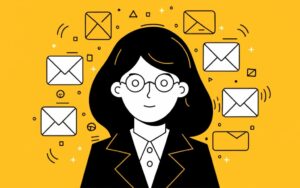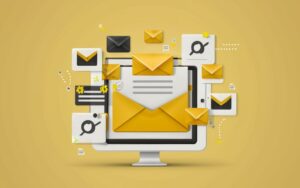The average company can receive between 100 and 150 emails per day. To make sure your business stands out in a sea of inbox clutter, you need to personalize your email marketing.
Personalization is more than just using a first name in your email subject line. In fact, there are many personalization tactics you can use to make your email campaigns more relevant to your subscribers and, in turn, more effective.
To help you get started, we’ve compiled a list of our favorite email personalization tips. Use these tips as inspiration for your email campaigns and start sending better emails today.
1. Get personal with the subject line
The subject line is the first thing your audience sees. If it’s not personalized, you’re missing a huge opportunity to make a great impression.
In fact, a study by Yes Marketing found that emails with personalized subject lines generate 50% higher open rates. And, when you consider that 47% of people decide whether to open an email based on the subject line alone, you can see how important it is to get this right.
In addition to using your recipient’s name, you can also add their location or company name to your subject line. This is a great way to improve your open rates and make your emails feel more personal.
2. Use the recipient’s company name
If you want to get even more personal, you can use the recipient’s company name in the email. This is a great way to show that you’ve done your research and that you’re not just sending out a generic email to everyone.
Using the company name can also help to make the email feel more relevant to the recipient, which can increase the chances of them opening it and taking the action you want them to take.
For example, if you’re sending a sales email, you could mention the recipient’s company name in the subject line or the opening paragraph of the email to grab their attention and make it clear that you’re not just another sales rep. You can also verify key business or individual information with a quick public records lookup before reaching out ensuring your message is both accurate and credible.
3. Send emails from a person not a company
You don’t always have to send your marketing emails from your company’s name. In fact, if you’re trying to personalize your emails, you should send your emails from an actual person.
When you send your emails from a real person, your subscribers are more likely to open your email and click through to your offer. This is because your email is more likely to be personalized, and your subscribers are more likely to trust a person over a company.
For example, if you have a marketing agency, you could send your emails from your CEO. If you have a beauty brand, you could send your emails from your head of marketing.
It’s easy to spot a generic email blast. They’re typically sent from a company email address, and they’re addressed to the recipient using their name.
If you want to stand out in a crowded inbox, consider sending your marketing emails from a person at your company. In fact, emails sent from a person’s name are 35% more likely to be opened than emails sent from a company name. For added impact, you can even include insightful HR quotes at the bottom of your email signature, something that subtly reflects your company’s values while adding a human touch.
4. Use segmentation to personalize content
Segmentation is one of the most popular email personalization techniques out there, and it’s not hard to see why. With segmentation, you can divide your email list into smaller, more targeted groups based on certain criteria. This allows you to send more relevant content to your subscribers, which can lead to higher engagement and conversions.
There are many different ways you can segment your email list, from basic demographic information like age, gender, and location, to more advanced factors like audience profile, website activity, and email engagement.
Here are a few examples of how you can use segmentation to personalize your email content:
• Send targeted offers and promotions to customers based on their purchase history.
• Create different versions of your email campaigns for different age groups.
• Send location-based content to subscribers in different cities or regions.
• Segment your list based on email engagement and send re-engagement campaigns to inactive subscribers.
In short, the more you can segment your email list, the more personalized you can make your email content. And the more personalized your email content, the better your results will be.
5. Use dynamic content
Dynamic content is the content in an email that changes based on a person’s profile or past behavior. It’s a great way to make sure your emails are as relevant as possible.
You can use dynamic content to personalize your subject lines, headline, body text, images, and more. For example, you could show different products to different people based on their past purchases or display different headlines based on a person’s location.
You can also tailor visuals by using tools that let you remove background from images, helping you present products or people more cleanly and contextually in personalized emails.
In the example below, you can see how the email changes based on the recipient’s location. If you live in New York, you’ll see a different headline than if you live in California.
6. Use location-based personalization
Location-based personalization is when you use a recipient’s location to personalize an email. You can do this by using a recipient’s IP address or by asking them for their location when they subscribe.
The most popular way to use location-based personalization is to use a recipient’s city or state to personalize content in the email. This can be as simple as using a recipient’s city to personalize the subject line or as complex as using a recipient’s city to personalize the entire email.
For example, you could use a recipient’s city to show them a list of local events in the email. Or, you could use a recipient’s state to show them a list of local stores where they can buy your products.
Location-based personalization is a great way to make your emails more relevant to your recipients. And, it’s especially effective if you have a local business or if you’re trying to target a specific geographic area with your emails.
7. Personalize based on behavior
Behavior-based personalization allows you to send the most relevant content to your subscribers based on what they’ve done in the past.
This type of personalization is powerful because it can help you increase engagement and conversions by showing your subscribers that you understand their needs and preferences.
Here are a few different types of behavior-based personalization you can use in your email campaigns:
• Personalize based on past purchases: If you have an ecommerce store, you can use past purchase data to recommend products that are similar to what your subscribers have bought in the past. Tools like ReferralCandy can also help you identify and reward loyal customers based on their purchase and referral behavior, adding another layer of personalization to your campaigns.
• Personalize based on website behavior: You can use data from your website to personalize your email campaigns. For example, you could send a special offer to subscribers who have visited a specific product page on your website.
• Personalize based on email behavior: You can use data from your email campaigns to personalize your future campaigns. For example, you could send a follow-up email to subscribers who opened an email but didn’t click on any of the links.
Implement form tracking to understand how users interact with your sign-up or lead capture forms enabling you to follow up with tailored content based on where they dropped off or what fields they completed.
Behavior-based personalization allows you to create highly targeted email campaigns that are more likely to convert.
8. Personalize based on purchase history
If you have an online store, you can use data from your customers’ purchase history to create personalized email campaigns.
For example, you could send an email to a customer who recently made a purchase with product recommendations based on their previous purchases. Or, you could send a customer an email with a coupon code for a product they’ve shown interest in, but haven’t purchased yet.
You can also use purchase history data to segment your email list. For example, you could create a segment of customers who have made a purchase in the last 30 days and send them a thank you email with a coupon code for their next purchase.
9. Use personalized email signatures
in the past, you may have noticed that some of your favorite sales reps had really great email signatures. They were professional, but they also had a personal touch. Some would include the rep’s phone number, email address, and even a link to their LinkedIn profile.
Now, there are tools that let marketers create personalized email signatures. You can use these to include the recipient’s first name in the signature, or even include the rep’s headshot. This is a great way to personalize your emails and make them stand out.
10. Personalize your email’s send time
Email send time personalization is a top way to use personalization in your email marketing. It’s also a simple way to get started with personalization.
The idea is to send your emails at the right time for each individual subscriber. You can determine the best time to send to each subscriber based on their past email engagement.
If you have a large list, this can be a time-consuming process to do manually. But, you can also use email marketing automation to make it easy. With email marketing software, you can set up a “send time optimization” feature that will automatically send your emails at the best time for each individual subscriber.
Another way to do this is by segmenting your list based on time zones. Then, you can schedule your email sends to go out at the best time for each time zone.
By personalizing your email send times, you can increase your email open rates and engagement, since your emails are being sent at the best time for each subscriber.
11. Use personalization to improve your email marketing
Personalization can have a significant impact on your email marketing. According to research, personalized email campaigns deliver six times higher transaction rates.
But personalization is more than just using a first name in your email copy. As you can see from the tips above, there are countless ways you can personalize your email marketing to make it more relevant and engaging for your subscribers.
The key is to use the data you have to create a more personalized experience. This means segmenting your email list, using dynamic content, and personalizing the timing and frequency of your emails.
By doing so, you can increase engagement, drive more sales, and build stronger relationships with your subscribers.
Conclusion
Email personalization is one of the best ways to increase engagement and boost your conversions. If you follow the tips in this post, you’ll be well on your way to creating a personalized email strategy that helps you grow better.




